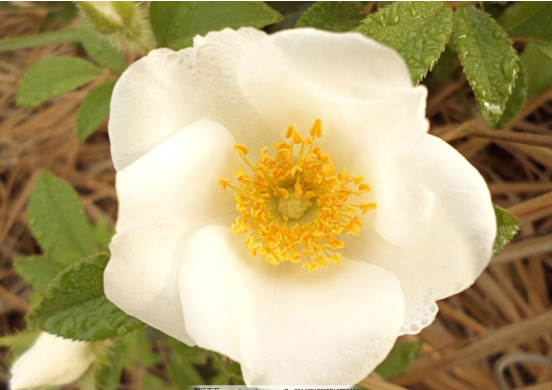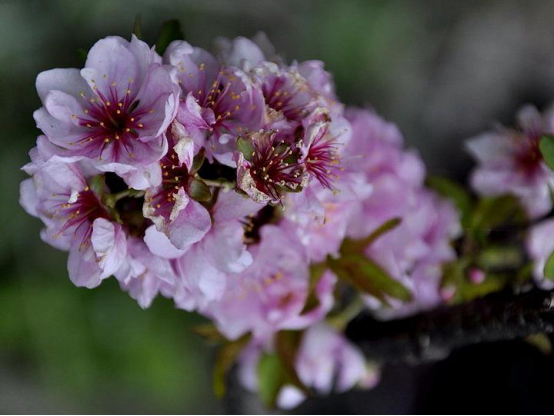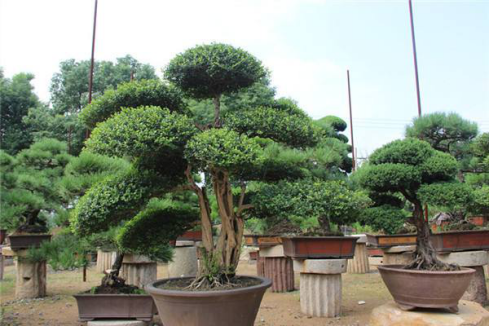Silkworm culture
Silk reeling flowers like a warm and sunny environment, but they are not afraid of cold and shadows, so when raising silk reeling flowers, they should be given enough light and suitable temperature.
First, sprinkle water
Silk reeling flowers need to ensure that there is enough water when they are cultured, and it should be noted that they should be given enough water when it is dry in summer, enough water should be provided during the flowering period, so that they can bloom luxuriantly and beautifully, and drainage should be done well in the dry season, without stagnant water, to avoid rotting the rhizome.
Second, fatten up
In order to make the silk reeling flowers grow healthily, it is necessary to provide enough fertilizer for them. During the growth period of silk reeling flowers, they should be diligent in fattening, at least once a month. When the temperature is higher and drier, a little thin fertilizer can be applied. In winter, reduce the number of times to apply fertilizer, in addition, after flowering, but also apply quick-acting fertilizer once or twice.

III. Methods of reproduction
The reproduction of silk reeling flowers is usually the method of cultivation and reproduction, so it can not only sow in spring but also in autumn, but it is more difficult to survive, so when cultivating silk reeling flowers, we mostly choose the method of cutting.
4. Pruning
In the growth of silk reeling flowers, pruning is necessary, whether it is pruning long branches, too dense branches, withered branches, diseased branches or pruning residual flowers and rainy buds. Pruning can make the reeling flower beautiful, ventilated and transparent, make the plant grow and develop very well, reduce the occurrence of some diseases and insect pests, and reduce the consumption of nutrients, so that it can blossom very well.
5. Diseases and insect pests
The diseases and insect pests of silk reeling flowers are less, but there will still be damage from shell insects, saw wasps, aphids, beetles, rose leaf wasps and other pests, as well as powdery mildew, black spot, anthrax, leaf rust and other diseases. This requires specific prevention and treatment according to the incidence of the disease.
The self-value of silk reeling flowers is also huge! On the one hand, as a kind of beautiful flowers, it has high ornamental value; on the other hand, silk reeling flowers also have high medical value, and its fruits are rich in vitamins B, P and C. at the same time, it also has the effects of eliminating food and invigorating the spleen, relieving diarrhea and so on.
Silk reeling flower is such a kind of "treasure" plant, have you learned how to raise it?
How to raise Silk reeling Flowers
Silk reeling flowers are native to southwest China. Like warm, humid and sunny environment, strong adaptability, high ornamental, many people who love flowers have planted. How to raise silk reeling flowers? In this article, the editor will share with you the culture methods of silk reeling flowers.
Adequate fertilizer and water should be guaranteed in cultivation and fertilized once a month from early spring to early summer. Pay attention to properly pruning and removing branches bent to the ground to facilitate ventilation and light transmission. In the process of growth, the base and trunk are easy to grow branches, sprout short flower branches in the second year, and blossom and bear fruit.
Watering: the roses planted in the ground should mainly pay attention to watering enough water during summer drought, especially in the bud and flowering period, and at the same time, we should also pay attention to not accumulating water in the rainy season.
Fertilization: winter ploughing can apply human dung and urine or sprinkle with mature organic fertilizer, and then turn into the soil, rose peanuts should be fertilized frequently for a long time, and topdressing 1-2 times after flower fade. Thin fertilizer should be applied in high temperature and drought, the last fertilizer should be applied before winter, and weeds should be removed in time before fertilization.
Pruning roses in summer is mainly to cut off the sprouting branches of grafted rootstocks, cut off residual flowers with leaves after flowering and remove excess buds, so as to reduce nutrient consumption and create good conditions for next flowering. In order to make the plant shape beautiful, you can cut off 3 or half of the long branch, 1 inch of the middle branch and 1 cm above the leaf. If the pruning is too light, the rose plant will grow taller and taller, the branches will be longer and thinner, and the flowers will be smaller and smaller.
Winter pruning depends on the variety and cultivation purpose, leaving branches during pruning, and paying attention to the overall shape of the rose plant, large flower varieties should leave 4-6 branches, 30-45 cm long to choose one side to grow strong buds, cut off its upper branches, vine or vine varieties are mainly to remove old techniques, cut off weak branches, diseased branches and cultivate the trunk.
How to raise silk reeling flowers, the breeding methods of silk reeling flowers, the editor will share with you here. I believe you have some understanding now, friends who like silk reeling flowers should start planting as soon as possible.
Breeding methods of silk reeling flowers
Silk reeling flowers, also known as Rosa roxburghii, wooden pear, thorn pear and so on, are shrub plants of the genus Rosaceae, with beautiful flowers and a dense circle of golden anthers in pink petals, which are very chic, yellow thorns are quite wild, and have high ornamental value. suitable for slope and roadside planting and greening, but also used as medicine Gracilaria materials, let's take a look at the breeding methods of silk reeling flowers!
Growth habits of silk reeling flowers
Silk reeling flowers are distributed in Shaanxi, Gansu, Jiangxi, Anhui, Zhejiang, Fujian, Hunan, Hubei, Sichuan, Yunnan, Guizhou, Xizang and other places. Like warm, humid and sunny environment, strong adaptability, more cold-resistant, slightly shade-resistant, lax requirements on the soil, but fertile sandy loam is better.
Propagation methods of silk reeling flowers
1. Sowing: silk reeling flowers are usually collected in September, can be sowed in autumn or stored in sand until the following spring, and generally germinate 20-25 days after sowing. Seeds can be used to raise seedlings, but it is generally not recommended to use seeds for cultivation because it is difficult to survive. In production, it is easy to survive by raising seedlings with tender wood cuttings in the same year. Valuable varieties are more difficult to cuttage.
2. Cutting: silk reeling flower cuttings can be cut in early spring or plum rain season. It is easy to survive with tender wood cuttings in the same year. After cutting, attention should be paid to keeping the cutting substrate moist, but it should not be too wet, otherwise it will cause rot. At the same time, we should also pay attention to the humidity of the air, can be covered with plastic film to maintain humidity, but should pay attention to ventilation in a certain period of time.
Culture methods of silk reeling flowers
1. Lighting: silk reeling flowers like a warm and sunny environment, which can be cold and shady, so when reeling flowers are cultured, they should be given sufficient light and maintain a suitable growth temperature.
2. Watering: silk reeling flowers need to ensure adequate moisture during maintenance, but pay attention to adequate moisture during summer drought. In the flowering period, it is also necessary to ensure adequate water supply in order to bloom luxuriantly and brightly. In the rainy season, we should pay attention to do a good job of drainage, there is no stagnant water, so as not to make the roots rot.
3. Fertilization: in order to make silk reeling flowers grow healthily, it is necessary to ensure sufficient fertilizer and water. During the comfortable growth period, you need to be diligent in fertilization, which can be applied once a month. You can apply some thin fertilizer when the temperature is higher and drier, reduce fertilization in winter, and apply quick-acting fertilizer once or twice after flowering.
4. Pruning: pruning is essential, whether it is too long branches, too dense branches, dead branches, diseased branches or residual flowers, rainy buds are very necessary, pruning can be reeling flowers beautiful, and conducive to ventilation and light, so that plant growth and development is better, reduce the occurrence of some diseases and insect pests, and reduce the consumption of nutrients, better flowering.
Disease and pest control of silk reeling flowers
1. Powdery mildew can occur in leaves, petioles, shoots and buds. At the initial stage of the disease, 20% triadimefon EC 1000 times or 20% triadimefon sulfur suspension 1000 times and carbendazim wettable powder 1000 times were sprayed. If there is resistance to the above fungicides, 12.5% nitrilazole EC or 3000 times Teflin wettable powder can be sprayed instead. Spray Baume 2 / 3 stone sulfur mixture or 45% crystal stone sulfur mixture 40 / 50 times before sprouting in early spring to kill overwintering bacteria.
2. Black spot: black spot mainly affects the leaves, petioles and tender shoots of silk reeling flowers. at the beginning of the disease, the leaves appear purple-brown to brown spots, and when enlarged, they are mostly round or amorphous dark-brown spots. When black spot occurs in silk reeling flowers, carbendazim, methyl thiophanate, daconine and other drugs can be sprayed.
3. Anthrax: anthrax occurs sporadically, which can be treated simultaneously in the prevention and treatment of black spot and leaf spot. In late autumn and early winter, the garden was cleared in time to collect sick fallen leaves and burn them. Strengthen maintenance, proper pruning, thinning too dense branches, so as to make good ventilation and light transmission. If necessary, spray 20% long Ke suspension 500x solution or 78% Cobo WP 600x solution, 75% Daconine WP 600x solution, 50% Shi Bao Gong or Shi Bai Ke WP 1000 times, 25% Chitalin WP 500x.
4. Beetle: the beetle mainly harms the roots, leaves, buds and other parts, seriously affecting the yield and quality of flowers. Light trap, willow trap, oscillation trap and so on. When the damage is serious, 2.5% deltamethrin 2000-3000 times or 50% phoxim 1000-1500 times can be sprayed. The effect is good, but it must not be sprayed at flowering stage.
5. Leaf rust: leaf rust is a common disease of silk reeling flowers, which may occur in leaves and new branches. Serious illness will cause a large area of leaves to fall off, so that flowers lose their ornamental value, and even die. If you find this disease, to deal with it in time, you can use 800 times liquid triadimefon foliar spray, once a week, continuous 3-4, the disease can be basically cured.
- Prev

Culture method of Yu plum
First, temperature Yu Li's hometown is China, unlike its weak appearance, Yu Li can grow strongly in the three northeastern provinces, so the vitality of Yu Li is very tenacious, and it is also a kind of plant that is easy to feed. But Yu Li prefers warm and humid environments.
- Next

Cutting Propagation of potted Holly
Holly is mainly propagated by cuttings. Cutting propagation is simple and easy to work, rooting quickly, and the survival rate is also high, so it is widely used in production. Nursery bed selection of cutting seedbed should choose the place with high topography, deep soil layer, loose soil and good drainage and irrigation. Cutting selection of holly can be carried out all the year round.
Related
- Fuxing push coffee new agricultural production and marketing class: lack of small-scale processing plants
- Jujube rice field leisure farm deep ploughing Yilan for five years to create a space for organic food and play
- Nongyu Farm-A trial of organic papaya for brave women with advanced technology
- Four points for attention in the prevention and control of diseases and insect pests of edible fungi
- How to add nutrient solution to Edible Fungi
- Is there any good way to control edible fungus mites?
- Open Inoculation Technology of Edible Fungi
- Is there any clever way to use fertilizer for edible fungus in winter?
- What agents are used to kill the pathogens of edible fungi in the mushroom shed?
- Rapid drying of Edible Fungi

